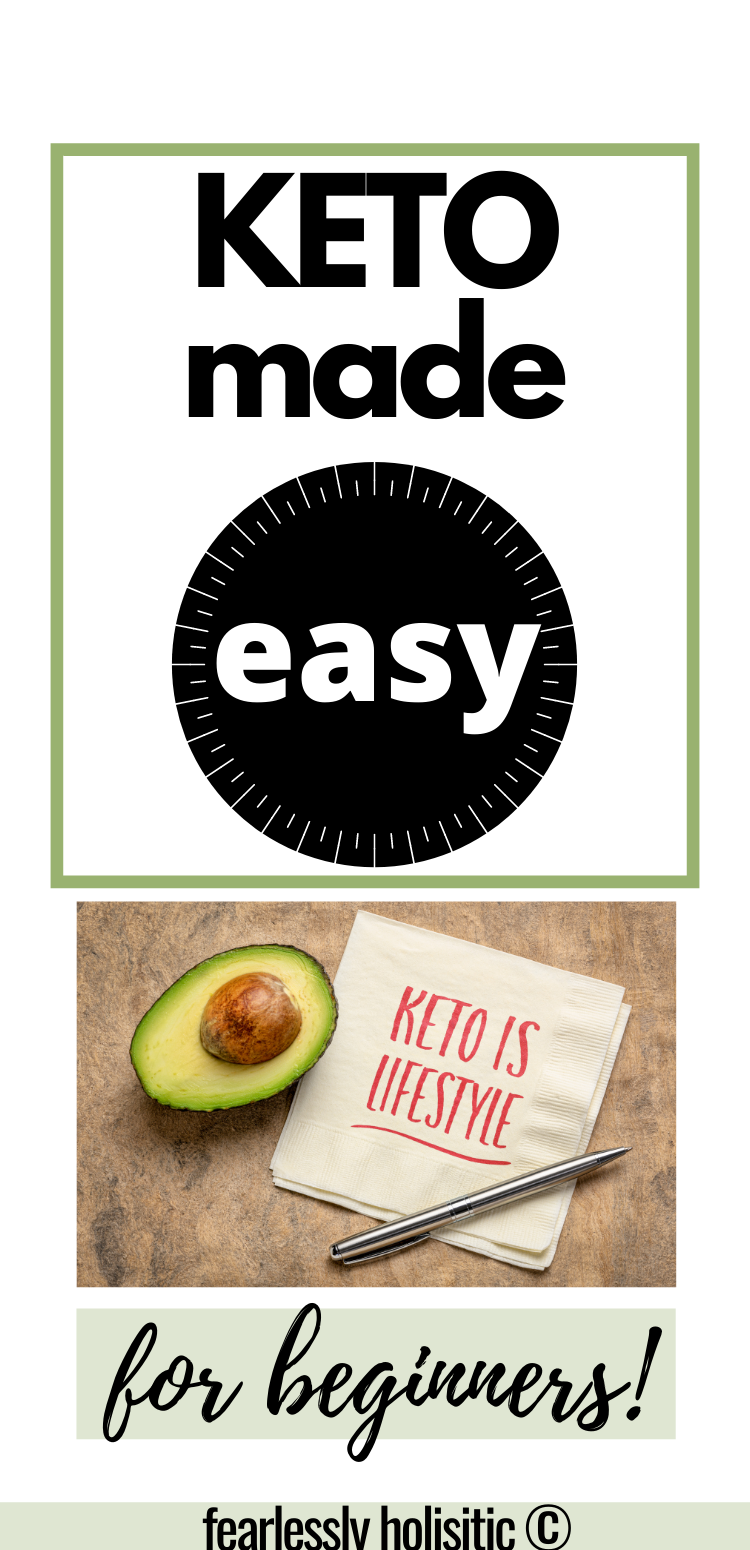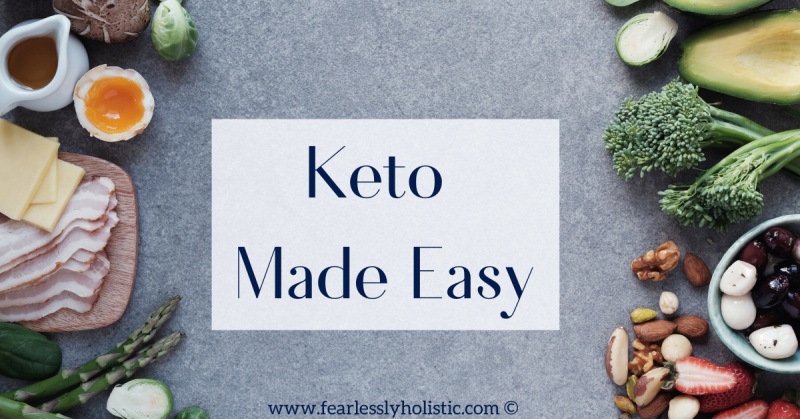Keto made easy…what could be better than easy? Keto and low carb diets are the simplest of all. Today, I will lay out the basics of this popular way of eating and in no time you will understand the benefits of using ketosis to improve your health.
Did you know the standard American diet (SAD) contains 45-65% of calories from carbohydrate rich food? Carbohydrate foods flood your body with sugar for quick energy. However, if you eat excess carbs (as the food guidelines suggest to us), your pancreas is stuck creating insulin to bring your blood sugar to normal levels again.
That is why there is an epidemic of obesity, Type II diabetes and health-related illnesses. Have you been stuck on that merry-go-round?
Welcome to Fearlessly Holistic
My name is Irma and I want to share my journey to improved health by eating whole foods, moving my body and eliminating stress as much as possible.
It is my hope to inspire you to join me in making daily changes to improve long term health. Eating fresh, seasonal food and getting some sunshine is the best way to increase longevity. But you do not want just a long life. You want a healthy, high quality long life.
Are you ready to ditch unhealthy foods and heal your health issues? I promote clean Keto foods like we ate for thousands of years. If this interests you then sign up for more information here and get my Keto Foods cheat sheet:
**My blog posts are my opinion and the results of things that I have tried that either worked for me or didn’t. My opinions are for informational purposes only and are not intended as medical advice. Medical advice should always be obtained from a qualified medical professional for any health conditions or symptoms associated with them**
The Ketogenic diet or Keto diet is a high fat, low carb way of eating.
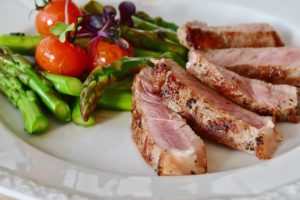
It allows for moderate amounts of proteins, natural fats like coconut oil or butter and vegetables. Foods high in fat like nuts, coconut milk, and butter are encouraged. It enforces a 4:1 ratio of fats to proteins and carbohydrates.
The only carbohydrates that you are expected to eat on this plan come from vegetables, preferably leafy green veggies. The diet forbids the consumption of pasta, bread, sugar, and grains.
This results in the ketones replacing glucose as fuel.
This fat metabolism reduces the systemic inflammation that can cause epilepsy and other diseases. It’s also what encourages the healthy weight loss process.
Now, before you jump into this way of eating you need to know what the Keto diet actually is, the pros and cons of the diet, and if it’s a good fit for you. It does have some drawbacks and it might not be for everyone. We’ll take a closer look at those later in this post.
Additionally, there are certain foods that you want to avoid and rules you should be aware of. This blog post will dig deeper into what to put on your plate.
Related Post: Ketovore For Better Health
What is the Ketogenic Diet?
It’s any diet that puts the body into a process called ketosis. This is the process where fats are burned for energy instead of using carbohydrates for energy.
Doing it correctly, the Keto diet asks the dieter to consume high amounts of fats (80% of daily caloric intake), moderate amounts of protein (15%) and very low amounts of carbs (5% or less).
With a traditional diet, our bodies normally turn carbohydrates into glucose.
This is sent throughout the body as a source for energy. You may read that glucose is the body’s preferred fuel source, but this is not accurate (it sells a lot of breakfast cereal though). Glucose is a short term fuel that burns off quickly and then requires you to eat more food to maintain. This is where the 3 meals plus 3 snacks idea comes from. I do not know about you, but I found that eating that often made my waistline grow. And grow. And grow.
If we were still hunter/gatherers we would have died off long ago. I mean what happens if you cannot find more food within an hour or two of eating? Not to mention that you get nothing else done when you are hungry and all you can think about is food.
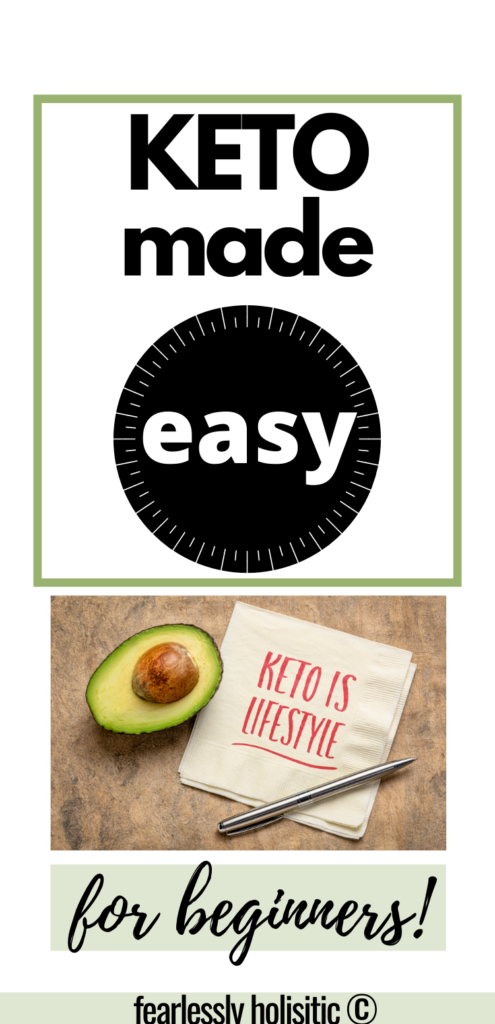
With ketosis, your body burns fat for fuel.
Not only does your brain love this (buh-bye brain fog!), but you can eat less often because fat is waaaaay more satiating sugar.
Carbs are devastating for the brain. ~ David Perlmutter
-
- On the Keto diet, we enter ketosis by limiting our carbohydrates causing our livers to start breaking down fat cells into fatty acids and ketones to be used as energy.
- Ketosis is attained when you eat a very low amount of carbohydrates. A good rule of thumb is 20 grams per day.
- Your diet consists of mostly fat, protein and green vegetables, which are all whole foods.
- On the Ketogenic diet, you will be eating healthy fats, like avocado’s, coconut oil, mayonnaise, and fatty cuts of meat.
- You will be eating a variety of vegetables, usually 2 cups of salad greens plus 1 cup of other veggies.
- It takes a few days for your body to flush the excess carbs from your blood, which can result in sugar cravings. Just be aware of this.
- On a traditional diet (SAD), it is recommended that most calories come from carbs, then protein and very little fat.
The Keto diet is not new
It became more popular in recent years thanks to Dr. Robert Atkins following the release of Dr. Atkins New Diet Revolution in the 1990’s. It’s easy to follow a plan that is highly effective, without feeling hunger or experiencing cravings.
The first part of the Dr. Atkins plan is equivalent to Keto
Dr. Atkins called this the “induction” phase. You would be eating less than 20 net grams (carbs minus fiber) of green, leafy carbs per day along with meat and fat. This is the book that I started my low carb journey with, and it is the basis of the keto diet.
I have also tried carnivore (specifically the meat and egg fast or fat fast) and very low carb (less than 5 grams of carbs per day). Both of these will help kick you out of a stall or can be used to stop sugar cravings if you fell off the wagon.
Another reason for Keto’s popularity is the possibility of losing weight without exercising.
Those who are severely obese have disabilities or injuries that prevent them from any type of regular exercise find this diet helpful in weight loss.
As well, if you are morbidly obese, you should see significant losses in the first few weeks.
Much of this is water weight in the first week, but if you have a lot to lose you will see much bigger losses than you might expect. This can be highly motivating. As you get closer to goal weight, you will find that you lose less per week, but this is perfectly normal.
Once you start to feel a bit better, you should start walking.
It is great for your mental health to be outside in nature, getting some sunshine and/or fresh air. Start with a walk around your home (inside or out), then around the block and then around the neighborhood.
If the weather is bad and if you have stairs in your home, walk up and down once. Do this 5 times in a week, and then try doing a second set. Then a third set. Add in some ankle weights or hand weights or just use an empty milk jug full of water and carry it with you.
Traditional use of the Ketogenic Diet
But before we get into the way you can benefit from it, I want to give you a little history on the diet.
The Keto diet has been in existence for over 90 years.
It was designed in 1924 by Dr. Russell Wilder at the Mayo Clinic and was based on research done by Rollin Turner Woodyatt . Traditionally used for effectively treating epilepsy, it fell from use after the surge of new anti-seizure medicines in the 1940s became popular.
It was later found that the ketogenic diet was helpful in treating epileptic seizures, often in cases where no other medicine helped.
Traditionally, the ketogenic diet for epilepsy is about 75% fat, 5% carbohydrates, and 20% protein.
It’s been used for a variety of medical conditions with success. Giving up carbs or sugar helps the body in many ways including weight loss.
The Keto diet is effective for weight loss but has many other benefits to your health including:
-
-
- Doctors usually recommend the ketogenic diet for children with epilepsy when their seizures have not responded to different seizure medicines.
- There is evidence from some uncontrolled clinical trials and studies in animal that the ketogenic diet can help in a broad range of neurological and neurodegenerative disorders including
- Alzheimer’s disease (here is an interesting story, from the Tampa Bay Times, about using coconut oil to improve alzheimer’s disease)
- Parkinson’s disease
- Multiple Sclerosis
- It may also help in cases of traumatic brain injury and stroke. (Source: NCBI.nlm.nhi.gov)
- Improves cardiovascular risk factors
- New research is showing the Keto diet can be helpful in treating Autism.
- Recent work in the last decade shows that the therapeutic effects of the ketogenic diet in many pathological conditions such as diabetes, polycystic ovary syndrome, acne, neurological diseases, and the amelioration of respiratory disease risk factors. (Source: NCBI.nlm.nhi.gov)
-
Related Post: Keto Basics for Beginners
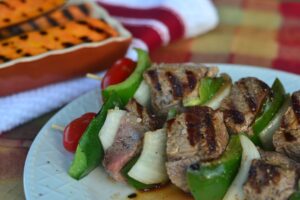
Why Keto for Fat Loss?
We’ve already seen the health benefits of a Keto diet. But why is it popular as a weight loss diet? The answer is simple, really.
The reason the ketogenic diet for fat loss is so popular is that it’s very effective. It uses the body’s natural behavior to burn off fat. It doesn’t leave you feeling hungry or experiencing cravings or those annoying side effects of low calorie diets.
As mentioned before, on the ketogenic diet you will lose weight even if you can’t exercise. It?s not recommended you don’t exercise unless there is a medical reason though. You will get better and faster results if you do exercise while on the Keto diet.
How does the ketogenic diet help with weight loss?
The secret to why the Keto diet is used for weight loss is in the type of food you eat. When you eat a high carbohydrate diet, your body uses the energy immediately. Any extra energy is stored for later, and it is stored as fat. Continuously eating more “sugar” than your body needs leads to weight gain and health issues.
If no sugar or glycogen is available, the body then uses the reserved fat as fuel. This is key to making keto work for you. Forcing the body to go into ketosis by limiting the amount of carbs you eat leads to your body burning fat.
This means you are actually burning the fat that has caused weight gain.
In fact, it’s almost impossible not to lose weight when your body is in this state.
-
-
- On the low carb diet, your blood sugar levels stabilize so you don’t experience the cravings for sugary foods or the ups and downs associated with fluctuating blood sugar.
- People feel consistently energetic and healthy when following a low carb diet.
- They have smaller appetites than they did before when on a Keto diet. This means they eat less without even thinking about it.
- The ketogenic diet is easy to follow. You eat fresh, whole foods found in any store or restaurant. Most processed foods are out as well as sugary foods.
- Fat and protein makes up the diet, making it high in flavor and very satisfying.
- Many people find it easier to control hunger on a ketogenic diet. Since carbohydrates are reduced in a Keto diet, blood sugar is controlled and insulin level spikes are minimized. When our blood-glucose levels rise rapidly, our insulin spikes and we feel hungry. By eating a low carb diet, our blood sugar remains steady.
-
The secret to losing weight on the Keto diet isn’t a secret.
Keto or low carb diets are the diets we, as a people, have eaten for thousands of years naturally. Eating whatever you can hunt or gather means your diet is naturally healthy, because your food is fresh and in season.
Decreasing your carb intake, increasing your fat and protein intake and eating fewer calories is why many people are using the ketogenic diet to lose weight.
Related Post: Clean Eating for Improved Health
Keto Made Easy: The Rules
Every diet has rules. The Ketogenic diet is no different. Of course, it would be great if we could eat whatever we want, whenever we want and still lose weight. But that is likely how we got unhealthy in the first place. In order to make the Keto diet work for you, you should follow a few easy rules.
Many people who are health conscious use an app like Cron-o-meter to stay on track with their macros. Macros is short for macro-nutrient and it describes fat, protein and carbohydrates. A keto way of eating keeps fat at 75% of daily calories, protein at 20%, and carbs at 5%.
Or you can try 80-15-5.
Personally, I need that bit of extra protein, so I go with 20% protein. A simple, visual way to figure out how much to eat is to use half your plate for veggies, 1/4 of your plate for meat, and 1/4 of your plate for fat. Follow this “visual” guideline for prepping foods.
An example might be: tossed salad (half plate) plus half a can of tuna (quarter of plate) and mayonnaise (you do not need to fill that part of the plate with mayo). Check this video from FatForWeightLoss:
Monitoring your macros can help you tweak keto to work best for you. In the beginning you may need more fat or more protein to feel good while in ketosis. Later on, after you get closer to your goal you can adjust this, and add in some more carbs in the form of fresh fruit or higher carb veggies.
Check the label for carbohydrate counts and the “per serving” sizes on pre-packaged foods. It should contain 2 grams or less for meat and dairy products and 5 grams or less for vegetables.
Choose one of the following foods when you are hungry. Once hunger dwindles, stop eating.
-
-
- Choose grass fed meats such as beef, pork, veal, lamb, wild game. In processed meats, like sausage, read the label to ensure there aren’t any added sugars or honey. Check meat jerky ingredient lists carefully, as many have sweeteners.
- Opt for poultry such as chicken, turkey, quail, duck, Cornish hen, or pheasant. Skin-on is preferable to add to the fat content. Do not bread or batter when cooking. Instead roast, stir fried, deep fry, bake, grill or barbecue.
- Get fish, seafood, and shellfish. Choose fresh and wild caught. Canned fish should be free of added sugar. Do not bread or batter when preparing.
- Eggs will become a staple in your ketogenic diet. They can be prepared in many ways including deviled, fried, hard-boiled, omelets, poached, or scrambled. And you may want to start making your own homemade mayonnaise.
- Keto is “salt friendly”, so add salt to your food if it needs it. Use quality salt like sea salt or himalayan pink. Avoid table salt, as it is poor quality
-
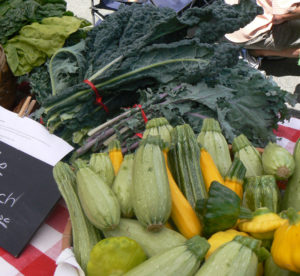
Eat one or two cups of salad greens every day:
-
-
- Salad greens of all kinds. You can use bagged greens as long as no high carb foods are included.
- cabbage
- kale
- chives
- lettuces
- parsley
- spinach
- radishes
-
Plus one cup of fibrous vegetables per day:
-
-
- Alfalfa and bean sprouts
- Asparagus
- Bamboo shoots
- Bell pepper
- Bok choy
- Black beans
- Broccoli
- Brussel sprouts
- Cauliflower
- Celery
- Chard
- Cucumber
- Green beans
- Jicama
- Mushrooms
- Okra
- Radishes
- Rhubarb
- Rutabaga
- Snow peas
- Sugar snap peas
- Tomatoes
- Turnip
- Wax beans
- Water chestnuts
- Zucchini
-
Eat these foods in limited quantities:
-
-
- Cheese – limit to 4 ounces a day. Most types including hard, aged like Swiss and cheddar, Brie, mozzarella, Gruyere, cream cheese and goat cheese. Avoid processed cheeses. Carbohydrate count should be less than 1 gram per serving.
- Dairy Cream – limit to 4 tablespoons a day. This includes heavy and light cream and sour cream. Do not use half- &-half or milk.
- Mayonnaise – limit to low-carb brands. Read the label for carb count or make your own. Here is a recipe from Wholesome Yum.
- Fatty vegetables like olives and avocados should be limited. Olives – serve up to 7 per day. Avocados – up to 1/2 an avocado per day.
- Condiments can include lemon or lime juice, small amount of ketchup, and soy sauce.
- Pickles – restrict to 2 servings a day. Dill or sugar-free are best.
- Snacks and miscellaneous foods including pepperoni slices, ham, beef or turkey spread with a cream cheese, deviled eggs, pork rinds, macadamia, almond or other nuts in a small amount, coconut butter.
- Drinks include unsweetened tea, unsweetened decaf coffee, herbal tea, water, flavored water (unsweetened), almond milk, coconut milk.
- Commercial spices usually contain sugar so check the labels and restrict the amount you use when possible. Many spices have carbs as well. Choose basil, black pepper, cayenne pepper, chili pepper, cilantro, coriander seeds, cinnamon, ground cloves, cumin seeds, dill, ginger, mustard seeds, oregano, parsley, peppermint, rosemary, sage, thyme and turmeric.
-
Choose good fats and oils
Most kinds of oil, butter, and cream can be used in cooking including
-
-
- Beef tallow
- Organic butter
- Chicken fat
- Ghee (clarified butter that has been cooked a bit longer. It has a nutty flavor that makes plain meat taste amazing!)
- Lard (avoid the use of fats with stabilizers. If you can, buy pork fat and melt (render) it yourself.)
- Olive oil
- Coconut oil
- Avocado oil
- You can also supplement with MCT (medium chain triglyceride) oil. Add it to your morning coffee for “Keto” coffee. Your brain will thank you!
- It would not be keto without fat bombs. An example of a savory fat bomb would be a keto-friendly cheese ball.
-
For salad dressings, choose avocado oil, almond oil, macadamia oil, mayonnaise, and most nut oils.

Tips for Keto Made Easy
Just imagine you have been following the Keto diet for a while, when suddenly you find it hard to stick to the rules. You want to add some carbs. Or you are tired of the same old meals. Or maybe you aren’t getting any support from those around you.
Here are some tips to help you stick to the diet.
Get support. Join online groups and forums where others are following the same diet (search keto groups in Facebook). Encourage friends and family to join you on the ketogenic diet. There are tons of inspirational Keto diet channels on YouTube.
Focus on the good things. Focus on what you have already achieved. Do you feel more energetic? Has your sleep improved? How do you feel compared to before you started the Keto diet?
Get back on if you fall off. If you do slip and eat a slice of cake or drink a beer, don’t give up. It’s unrealistic to expect you won’t fall for temptation occasionally. Sometimes those sugar cravings are really a signal to eat more protein (protein converts to sugar in the liver, but do not limit protein for this reason. Just keep trying to find your sweet spot).
The point is to get right back to choosing healthy choices. Remember though, that when you eat a certain amount of carbs your body comes out of ketosis. That means it will take you a couple of days to get back into it, and that comes with sugar cravings…again.
Be prepared. Get the supplies, books, and the foods you need before you begin the diet. Watch YouTube videos on how to meal prep, so that you are not tempted to cheat.
Set up an accountability system. Get someone to hold you accountable to sticking to the plan. Check out forums like Active Low Carber to find supportive co-dieters. It is free to join. There are many people eating low carb in a variety of ways, so check out the tips, success stories, and accountability threads to find a diet-buddy.
Add exercise. After the first month, add an exercise program. Start with a timed walk, and then try to beat your time for the same distance. Adding in weight training will help you develop the physical form that you want to see when your weight has burned off.
Be patient and don’t cheat. It will take time for your body to begin burning fat and to get into ketosis. Stick to it and be consistent with it. Don’t weight yourself every day, and instead weigh in only once per week.
Track your progress and eating habits. Use a written journal, electronic notepad or a mobile phone app. Measure and write down what you eat. Keep track of calories, fat, protein and carbohydrate intake. Again, check out the My Fitness Pal app or another similar one.
As you can see, you aren’t alone in this journey. There are many ways to get support when you feel like stopping. Being patient and consistent with the plan is the first step. It gets easier and the more support and accountability you have, the more likelihood you’ll stick it out.
Measuring Progress and Your Results
No doubt, one of most motivational things about losing weight is being able to see and measure your results. I mean, you look in the mirror and see a leaner you and your clothes are getting looser.
Can you imagine how great that feels? Those are great feelings to be sure. But, you need to measure your progress truly to get the reassurance you need that the Keto diet is working. There are different ways to monitor your success on this plan.
One way is by measuring ketosis.
The way this is done is by testing the bi-product ketones of the process that are released from the body. They come out in your breath, sweat, and urine.
Self-testing urine strips for testing your urine allows you to see when your body first goes into ketosis and that you are staying in ketosis. The strips are neutral in color and change to shades of pale pink to deep purple during ketosis. The darker the color the more ketones you are burning. Later one you can purchase a blood ketone meter.
Another option is to have a complete blood chemistry test done before you start
And then another one 1 month into the diet. This will show your cholesterol and blood sugar changes.
You can measure weight loss by weighing yourself once a week, preferably at the same time. During the first week, you will likely see a significant change. This is usually water weight and is a natural process when you change your way of eating. Processed foods make us retain water because they are so high in crappy sodium.
Measure yourself as a way to keep track of weight loss. If you are working out while on the diet, you may gain weight through lean muscle mass. To measure that you are losing weight you need to see if you are losing inches.
Measuring and tracking your weight loss while on the ketogenic diet is an easy process and will help keep you motivated to continue.
Keto Made Easy: For Your Health
The fact is millions of people have successfully used a type of low carb diet including the ketogenic diet as a way to lose weight. It’s a popular way to lose weight since it is highly effective. It uses the body’s natural fat burning ability to burn fat without leaving you hungry, experiencing cravings, or suffering from the negative effects of too few calories.
Will it work for you? Maybe or maybe not.
You will be the one who has to decide. Are the side effects more than you want to deal with? Is the fast weight loss worth giving up your favorite carbs for?
With those questions in mind, take a look at some of the pros of the diet.
We’ve already seen that the ketogenic diet has been used in the treatment of epilepsy. It’s now being used for many other health issues as well including reducing cardiovascular risk, cancer risk, the treatment of many neurological issues. The health benefits include weight loss, which in turn can alleviate all sorts of health issues from joint pain to risk of stroke and diabetes.
You should be aware of the cons as well.
-
-
- One of the major problems with ketosis is the risk to high-level athletes and people with high-energy jobs in not getting enough energy to work.
- Some people have trouble sticking to the diet especially if they enjoy social functions. Try eating keto at home and then picking keto-friendly foods when out.
- A mistake that some people make is to cut out all fruit and vegetables. This is a mistake, as you need the fiber from vegetables, as well as the nutrients. You can also eat berries if they fit with your macros. As you get closer to goal, you can add in seasonal fruits and see how it affects you.
- The ketogenic diet is perfectly safe. Eating very low carb or carnivore can get tedious, but may be necessary to stop food cravings and certain auto-immune issues.
-
A normal or traditional carbohydrate rich diet allows us to eat larger amounts of protein and carbohydrates than we do fat. The body burns the sugar from the carbs for energy and stores the extra fat.
The ketogenic diet though is almost totally opposite. It encourages us to eat much higher levels of fat with very little carbohydrates and some protein. The body burns or uses fat for energy from the ketones produced on the diet.
Potential Drawbacks of the Diet
The ketogenic diet has many myths associated with it. Let’s look at that.
Ketosis may lead to hypothyroidism and possible adrenal fatigue
The belief for this is that the lower level of glucose from the diet can lead to a diminished capacity for T4 to convert to T3. This can lead to hair loss, cold hands and feet, general sickness and low thyroid function symptoms.
According to Dr. Ron Rosedale, a “lower number does not necessarily mean lower function; often it means better function.” The thyroid levels return to a desirable level, which could be lower, when the body is operating optimally.
Oftentimes people confuse diabetic ketoacidosis (DKA) which is bad with nutritional ketosis which is actually a good thing. Dr. Peter Attia has a great explanation of both on his The Eating Academy blog.
Adrenal fatigue
While rumors abound and studies are still being done, many medical professionals suggest that chronic stress is the #1 cause of adrenal fatigue, not your diet. However if your body is not working at peak proficiency, you need to address those issues prior to beginning any diet or exercise regimen.
In addition, when you first start going into the metabolic state of ketosis, you may feel sluggish, have a brain fog and fatigue. But once the body gets used to it, you’ll actually experience higher levels of energy, more clarity and better performance overall. Be sure to add salt (sea salt or pink himalayan salt) to your meals to avoid any keto flu symptoms.
It says to eat fat but I thought fat is bad?
Many people are afraid to try the ketogenic diet plan because of their fear of increasing the amount of fat they eat, especially saturated fat. We’ve been told for over 40 years that fat is bad, but there is not one single piece of evidence that backs up this claim. Fat does not make you fat the same way that eating protein does not automatically make you muscular.
The reality is a high carb diet increases your blood sugar and insulin levels. These are what cause inflammation and heart disease. A ketogenic diet is high in fat and low in carbs so it reduces inflammation. (Source: ncbi.nlm.nih.gov)
Use healthy fats and oils in your diet and you can lay this fear to rest.
No carbohydrates can leads to nutrient deficiencies
During the no-carb phase of the diet carbohydrates are very restricted which may lead some people to believe that you won’t get your daily recommended amount of certain vitamins and minerals. If you are eating your full allotment of green, leafy veggies you will be getting more nutrients, not less.
However, if you think that you need to, try taking a multivitamin and mineral supplement each day. As you get closer to your health goal, you can add in seasonal fruit if it does not affect your blood sugar levels.
Your gut health will suffer
Gut health has been in the news in recent years. Many people believe that we need certain dietary fiber to feed our gut microbiome. And they believe we can’t get that without eating certain foods.
Dr. William Davis has said that people on a ketogenic diet can get an adequate amount of indigestible fibers to feed their gut flora. The fiber content of non-starchy vegetables is enough to feed the microbiome.
In addition, you can improve your gut health by supplementing with probiotics, some fermented foods like sauerkraut, kimchi and raw full-fat plain yogurt, ketogenic amino acids such as leucine and lysine and coconut oil or Caprylic acid.
Related Post: Improve Your Gut Microbiome Today!
Side Effects
There are some side effects of the ketogenic diet as well. When making sudden and dramatic changes to your daily diet you might experience mild but temporary side effects like the following.
-
-
- Headaches and dizziness. Sugar and caffeine both have addictive effects so when you give them up in the induction phase of the Keto diet, you have withdrawal symptoms. They will only last a few days. You can counteract this by drinking some salty broth, dairy foods, green leafy veggies and avocados.
- Leg cramps. You may experience cramps in your legs especially at night. They usually occur during the early phases of the diet. The lack of potassium in the diet is the cause. It is recommended to take multivitamin containing potassium while on the diet. Also look for keto diet approved foods that are also high in potassium such as avocados and raw green leafy vegetables. You can also use a salt substitute if it contains potassium.
- Constipation. Constipation can come from not getting enough fiber. Make sure the carbs you are eating are from green vegetables and you are drinking plenty of water.
- Sugar cravings. As your body is moving from burning sugar to fat, there will be a period of 2 to 10 days when your carb cravings may be worse. Eat 4 ounces of protein or a fat bomb if you are hungry. Try to wait it out as they do eventually disappear.
- Bad breath. Your body burns fat to use for energy when you are on the ketogenic diet. This is known as ketosis. The byproduct of this process is the release of ketones that are released through your breath and urine. To get rid of the smell chew fresh mint, parsley, or use sugar free gum or a breath spray.
-
Related Post: (opinion) Greta Thunberg is Not The Boss of Me!
Conclusion
Like any diet, change there will be some side effects. The good news is that on the ketogenic diet they are temporary and don’t last long. Being aware of what they are and what to do about them will help you get through them.
All things considered, if you are interested in beginning the ketogenic diet, you need to weigh the pros and cons and get expert opinions on whether this is the right diet for you. Your body loves eating clean and healthy foods that do not contain artificial ingredients that age you quicker.
If this sounds good to you, sign up for my weekly newsletter and get a Keto food guide to take shopping:
I chose Atkins induction, which is the same as Keto, because it encourages me to eat more seasonal foods. Foods that are out of season (like strawberries in January) are often heavily sprayed and nutrient void (because they are forced to grow unnaturally). Whenever possible, choose locally grown and organic foods for your health.
And follow me on Pinterest!
Here’s to our health!
-Irma 🙂
